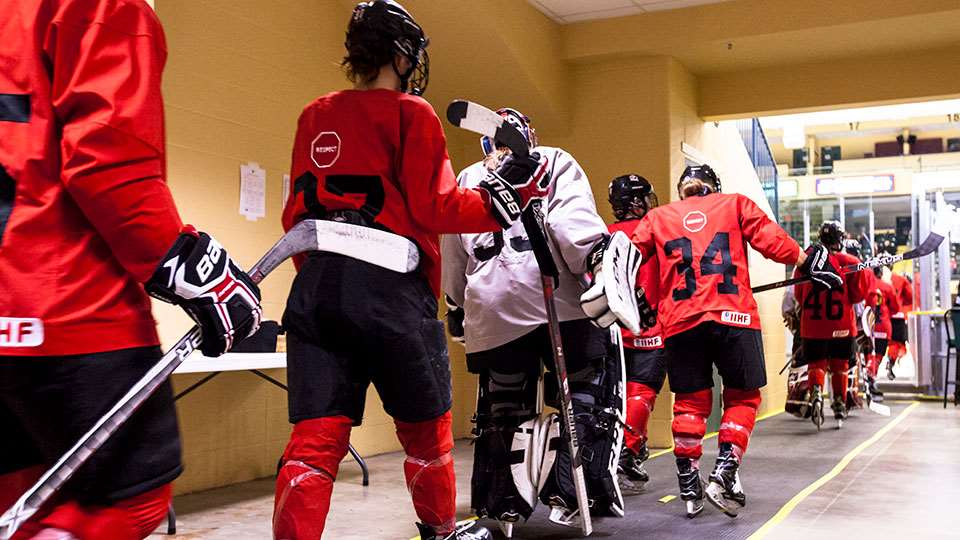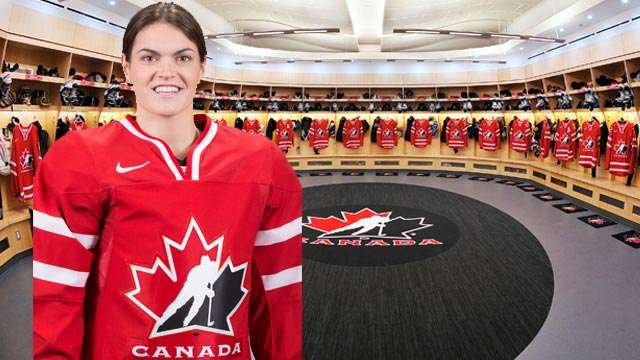

Generation next
A new Olympic cycle brings new opportunities

Jillian Saulnier was nine years old when Canada’s National Women’s Team won gold at the 2002 Olympic Winter Games.
Watching the likes of Cassie Campbell, Jennifer Botterill and Geraldine Heaney from the comfort of her living room in Halifax, N.S., Saulnier was both transfixed and inspired.
“I was glued to the celebration,” says Saulnier, now 22. “I just knew I wanted to do that. I wanted to be there with those girls and wear that jersey and represent the country.”
That first chance came in the summer of 2008 when Saulnier was selected as a member of Canada’s National Women’s Under-18 Team for a three-game series against the United States. She’s worn the maple leaf nine more times since.
And as one of the 58 players who attended Canada’s National Women’s Team Fall Festival in September, Saulnier is hoping the next time is her first time with the senior club.
With only 11 of the 21 players who won gold in Sochi making an appearance at this year’s autumn camp, younger players like Saulnier, Jamie Lee Rattray and Erin Ambrose are getting a longer look as a new Olympic cycle gets under way.
“There are always changes in the first year of a quad,” says Melody Davidson, Hockey Canada’s general manager of national women’s team programs. “It’s not turn-over; it’s just opportunities for some players to see different experiences and other players to take a look at other things they want to do.”
“I think (at the start of) an Olympic cycle you want to put your stamp on Hockey Canada and show that you’re ready for that next level,” says Rattray, who at 22 has represented Canada eight times at the under-18 and under-22 levels.
Twenty-year-old Ambrose has already won three gold medals for Canada and knows suiting up for her country at the 4 Nations Cup in Kamloops, B.C., would be a step in the right direction to Korea in 2018.
“I’ve been in the program for a couple of years now and to make that jump to the senior level would be a huge honour,” says Ambrose. “I think I’m getting close to the point where’d I’d be able to get there.”
With the national team programs Hockey Canada has in place, Davidson has known these players since they were 15 and 16 years old. She’s excited about the opportunities that now lay ahead for them – but not as much as the women themselves, who, despite living in different parts of the country, have grown up together as hockey players.
“Every camp and every experience has been together,” says Kanata, Ont.-born Rattray about Saulnier. “We’re very close – best friends really. It would be a great story if we could (make the senior team) together.”
Ambrose, who hails from Keswick, Ont., agrees that there would be something extra special about ascending to the national team with players she’s long shared a bench with.
“To see those guys succeed means just as much to me as my personal success, so hopefully we can do this all together.”
Bailey Bram and Courtney Birchard have played together for Canada’s National Women’s Team in the past, both having 4 Nations Cup and IIHF Ice Hockey Women’s World Championship appearances – and gold medals – on their résumés. They spent last season centralized ahead of the Olympics, but were late cuts to the team that would go to Sochi.
They’re veterans, but veterans who are looking to reclaim a spot with the senior squad – and counting on lessons learned a year ago to help get them back there.
“Tons,” says Bram, 24, when asked what those six months in Calgary taught her. “You learn something new every day, whether it’s Tessa Bonhomme’s leadership or Gillian Apps’ way of being in the dressing room – how she calms everyone down. Unfortunately, I didn’t have the opportunity to go to Sochi, but I learned so much throughout the journey.”
Even as they fight for roster spots themselves, they recognize they’d be seen as leaders. It’s a position both embrace.
“I think a lot of my role is going to come in the dressing room, as I’m one of the older girls now, which is kind of funny to say,” says the 25-year-old Birchard. The younger players need to feel comfortable. “I remember what it was like being one of the younger kids. It’s definitely nerve-racking.”
It also helps having a handful of Olympic champions drive you. At the September camp Ambrose and Saulnier shared a dressing room with Laura Fortino, Rebecca Johnston and Jennifer Wakefield; and Rattray with Geneviève Lacasse, Jocelyne Larocque, Marie-Philip Poulin and Haley Irwin. The three youngsters needed only to look up to see the rewards of hard work.
“If you put the work in you can see there’s success there,” Rattray says. “Coming into a program with girls who have seen success and know what to do to get there, it’s easier as a younger player to say, this is what needs to be done to get to that level.”
But as inspired as this next generation of hopefuls is of their predecessors’ success, these players are now looking to pave their own way.
“It makes you want that so much more, just watching the Olympics last year and that gold medal goal,” says Ambrose. “Those things stick in your mind and you know you want to be a part of that someday.”
While the next Winter Games isn’t exactly top of mind with management – “Our focus isn’t on 2018, to be honest. We have seven major events to take us toward Korea,” says Davidson – the players have allowed themselves a sneak peak four years in the future.
“You can’t look too far ahead,” says Rattray, “but it’s also something you need to look at to see where you are and look forward to what you need to work toward.”
As these five players – and dozens more – look to be a part of the next national team, the general manager says it’s a bit of a double-edge sword watching players she’s seen grow get closer to their ultimate goal.
“It’s rewarding but frustrating,” says Davidson. “You’re excited for the opportunities they get and frustrated when they don’t recognize the ones in front of them. But for the ones who do (get it), you’re happy for them. You hope they continue on with all the success.”
For more information: |































